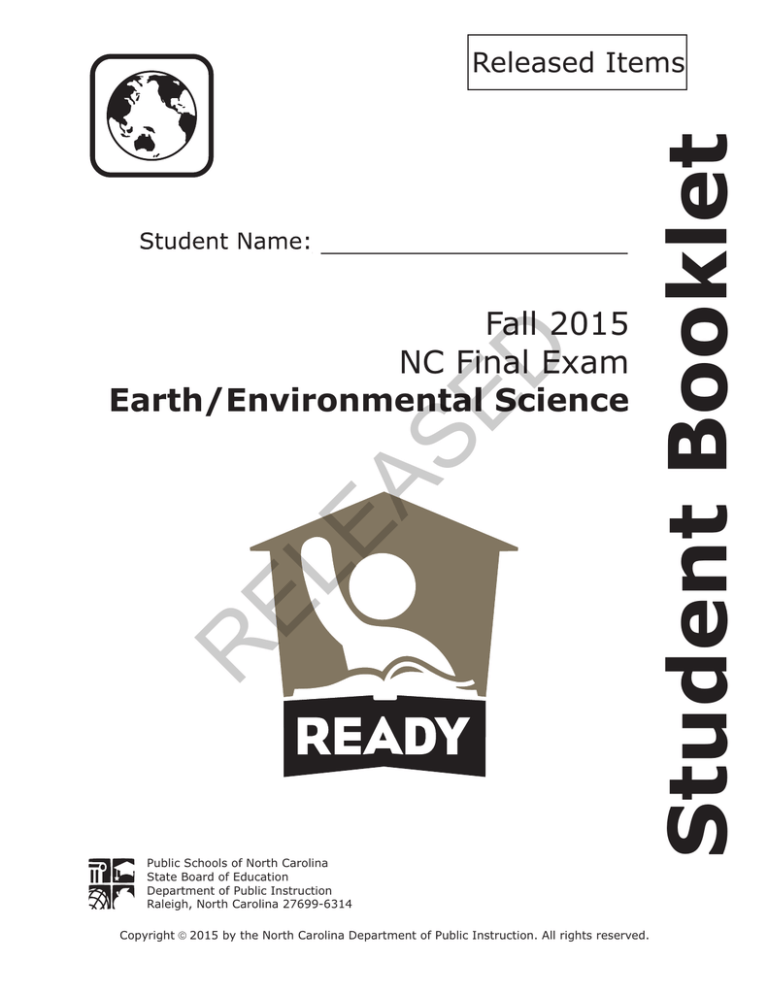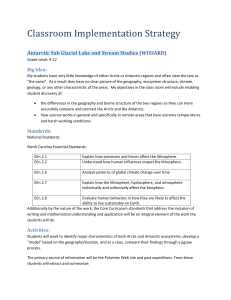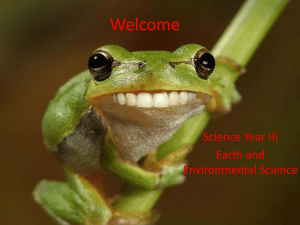
R
EL
EA
SE
D
Fall 2015
NC Final Exam
Earth/Environmental Science
Public Schools of North Carolina
State Board of Education
Department of Public Instruction
Raleigh, North Carolina 27699-6314
Copyright ã 2015 by the North Carolina Department of Public Instruction. All rights reserved.
Student Booklet
Released Items
EARTH/ENVIRONMENTAL SCIENCE — RELEASED ITEMS
B
It changes the chemical composition of the rocks.
C
It exposes rocks to increased rates of erosion and weathering.
D
It limits the exposure of rocks to acid precipitation.
How can urbanization affect a local area?
D
It reduces the rates of soil formation.
It can increase the number of invasive species in an area.
B
It can decrease the risk of water pollution in an area.
C
It can increase the risk of flooding in an area.
D
It can decrease the need for natural resources in an area.
SE
A
EA
3
A
Which is a farming technique that could improve the soil and the environment?
EL
2
Cracks in rocks widen as water in them freezes and thaws. How does this affect
the surface of the Earth?
A
using fueled machines that will turn the soil continuously
B
creating undisturbed layers of mulch in the soil
C
placing inorganic chemical fertilizers in the soil
D
irrigating the soil with salty water
R
1
1
Go to the next page.
EARTH/ENVIRONMENTAL SCIENCE — RELEASED ITEMS
B
differences in density of ocean water
C
the rotation of Earth on its axis
D
movement of the jet stream
D
differences in the topography along the ocean floor
What is most responsible for the presence of groundwater in an area?
the movement of water from a confined aquifer into surface water
B
the movement of surface water and precipitation through soil and rock
C
the movement of water from streams and rivers to watersheds
D
the movement of surface water through impermeable rock
SE
A
EA
6
A
Which is the most common contamination source for freshwater resources?
EL
5
Subsurface ocean currents continually circulate from the warm waters near the
equator to the colder waters in other parts of the world. What is the main cause of
these currents?
A
runoff
B
digging wells
C
melting of glaciers
D
lightning
R
4
2
Go to the next page.
EARTH/ENVIRONMENTAL SCIENCE — RELEASED ITEMS
It could cause a decrease in water demand.
B
It could cause a decrease in the water levels.
C
It could cause an increase in waterborne diseases.
D
It could cause an increase in the freshwater supply.
typhoon
B
tornado
C
blizzard
D
monsoon
SE
A
D
Which storm most likely develops as air masses interact with the warm water in
the northwest Pacific Ocean?
EA
9
A
Which is associated with an increase of chlorofluorocarbons in the environment?
EL
8
A community decides to upgrade its water purification and management systems.
What lasting impact could this have on available freshwater?
A
an increase in health risks associated with UV radiation
B
an increase in levels of methane gas in the atmosphere
C
an increase in ozone levels in the upper atmosphere
D
an increase in acid precipitation
R
7
3
Go to the next page.
EARTH/ENVIRONMENTAL SCIENCE — RELEASED ITEMS
A
movement of tectonic plates
B
deep ocean currents
C
seasonal changes
D
day and night
SE
Report for Urban City X:
D
Urban City X has been referred to as an urban heat island because it tends to be
warmer than the surrounding rural areas. The report below lists changes that have
occurred in one year in Urban City X.
Eight roads were repaved.
•
The population increased by 20%.
•
Public transportation increased by 5%.
•
Four new apartment complexes were built.
•
Plans were drafted to build a local park.
•
A meeting was held about alternative energy sources.
EA
•
EL
11
Which natural phenomenon occurs as a result of Earth rotating on its axis?
What is the main cause of Urban City X being an urban heat island?
A
the planting of trees and other vegetation
B
the building of rooftop gardens
C
the installation of solar panels
D
the construction of parking areas and road systems
R
10
4
Go to the next page.
EARTH/ENVIRONMENTAL SCIENCE — RELEASED ITEMS
decreased rates of erosion
B
increased atmospheric carbon dioxide levels
C
decreased amounts of acid rain
D
increased atmospheric oxygen levels
D
Why is it important to conserve the biodiversity of Earth?
to decrease the amount of global predator populations
B
to decrease the stability of major global ocean currents
C
to increase the stability of ecosystems during environmental changes
D
to increase the amount of nonrenewable resources located in the lithosphere
SE
A
EA
14
A
How does the tilt of the Earth’s axis affect the seasons?
EL
13
What long-term impact could the destruction of large areas of forests have on
Earth?
A
by changing the amount of direct solar energy reaching the surface of Earth
B
by influencing the rate of chemical reactions occurring in the atmosphere
C
by deflecting the harmful rays of radiation emitted by the sun
D
by changing the speed of the rotation of Earth
R
12
5
Go to the next page.
EARTH/ENVIRONMENTAL SCIENCE — RELEASED ITEMS
17
It could pollinate the native plant species, producing a disease-resistant
species.
B
It could reduce the competition for space and light with native plant species.
C
It could take over the habitats of the native plant species.
D
It could cause some insect species to destroy native plant species.
D
A
SE
Which change would best aid a farmer in making the transition from conventional
farming techniques to more sustainable farming techniques?
reduce the ratio of essential elements in the fertilizer
B
irrigate crops using well water
C
rotate the types of crops grown
D
plant only genetically modified crops
EA
A
EL
16
How could the introduction of a nonnative species of plant affect an ecosystem in
North Carolina?
Which would most likely cause a reduction in the amount of coal and natural gas
on Earth?
A
a continual increase in the amount of pollution in Earth’s atmosphere
B
a continual increase in the number of people on Earth
C
a continual decrease in the amount of water in Earth’s aquifers
D
a continual decrease in the amount of rain forests on Earth
R
15
6
Go to the next page.
EARTH/ENVIRONMENTAL SCIENCE — RELEASED ITEMS
increased incidences of skin cancer
B
decreased rates of photosynthesis
C
increased phytoplankton activity
D
decreased carbon dioxide levels
volcanic island arc
B
continental mountains
C
continental rift
D
oceanic trench
SE
A
D
Which will most likely form when movement along a plate boundary forces a
landmass to be pulled apart?
EA
20
A
Which will most likely occur before a volcanic eruption?
EL
19
Which is an effect of lower levels of solar radiation striking Earth?
A
an increase in acid rain production
B
an increase in earthquake activity
C
an increase in lava flow
D
an increase in mud flow
R
18
7
Go to the next page.
EARTH/ENVIRONMENTAL SCIENCE — RELEASED ITEMS
if the area has a large uncharged aquifer beneath it
B
if the water level in the area is below the zone of saturation
C
if the ground of the area is already saturated with water
D
if the ground of the area is mostly sandy soil
D
Which is the best way to conserve worldwide freshwater resources?
build more roads and highways for cars and trucks
B
increase the amount of land used to raise cattle
C
develop more modern coal-powered plants
D
use more efficient irrigation techniques
SE
A
EA
23
A
Which statement best describes the ozone layer of Earth?
EL
22
A rural, forested area receives a lot of rain in a short amount of time. What would
most likely cause potential flooding in the area?
A
It helps reduce the amount of ultraviolet radiation reaching the surface of
Earth.
B
It prevents the formation of severe storms in the stratosphere of Earth.
C
It increases the amount of nitrogen in the troposphere of Earth.
D
It forms a magnetic field in the mesosphere of Earth.
R
21
8
Go to the next page.
EARTH/ENVIRONMENTAL SCIENCE — RELEASED ITEMS
Which is a biotic factor that could affect an ecosystem?
dust storms moving through an ecosystem
B
bacteria harming the health of organisms in an ecosystem
C
large amounts of acid rain precipitation seeping into the soil in an ecosystem
D
high levels of carbon dioxide entering the atmosphere within an ecosystem
EL
EA
SE
D
A
R
24
9
Go to the next page.
EARTH/ENVIRONMENTAL SCIENCE — RELEASED ITEMS
This is the end of the Earth/Environmental Science Released Items.
Directions:
1. Look back over your answers for the test questions.
2. Make sure all your answers are entered on the answer sheet. Only what is
entered on your answer sheet will be scored.
3. Put all of your papers inside your test book and close the test book.
D
4. Place your calculator on top of the test book.
SE
5. Stay quietly in your seat until your teacher tells you that testing is
finished.
R
EL
EA
6. Remember, teachers are not allowed to discuss items from the test with
you, and you are not allowed to discuss with others any of the test
questions or information contained within the test.
10
EARTH/ENVIRONMENTAL SCIENCE — RELEASED ITEMS
Earth/Environmental Science
RELEASED Items1
Fall 2015
Answer Key
Type2
Key
1
MC
C
75%
EEn.2.1.3
2
MC
C
31%
EEn.2.2.1
3
MC
B
61%
EEn.2.2.1
4
MC
B
37%
5
MC
B
6
MC
A
7
MC
D
66%
EEn.2.4.1
8
MC
A
53%
EEn.2.5.3
Standard
SE
EEn.2.3.1
EEn.2.3.2
68%
EEn.2.4.1
EA
58%
MC
A
32%
EEn.2.5.5
MC
D
52%
EEn.1.1.2
R
10
EL
9
Percent Correct3
D
Item Number
MC
D
76%
EEn.2.6.3
MC
B
74%
EEn.2.6.3
13
MC
C
79%
EEn.2.7.2
14
MC
A
81%
EEn.1.1.2
15
MC
C
68%
EEn.2.7.3
16
MC
C
46%
EEn.2.8.2
11
12
1
EARTH/ENVIRONMENTAL SCIENCE — RELEASED ITEMS
Type2
Key
Percent Correct3
Standard
17
MC
B
63%
EEn.2.8.3
18
MC
B
58%
EEn.1.1.4
19
MC
C
50%
EEn.2.1.1
20
MC
B
66%
EEn.2.1.1
21
MC
C
71%
EEn.2.3.2
22
MC
D
84%
23
MC
A
24
MC
B
SE
D
Item Number
EEn.2.4.1
EEn.2.5.1
72%
EEn.2.7.1
EA
84%
1
2
EL
These released items were administered to students during a previous test administration. This
sample set of released items may not reflect the breadth of the standards assessed and/or the
range of item difficulty found on the NC Final Exam. Additional information about the NC Final
Exam is available in the Assessment Specification for each exam located at
http://www.ncpublicschools.org/accountability/common-exams/specifications/.
This NC Final Exam contains only multiple-choice (MC) items.
3
R
Percent correct is the percentage of students who answered the item correctly during a
previous administration.
2
EARTH/ENVIRONMENTAL SCIENCE — RELEASED ITEMS
Standard Descriptions
Only clarifying objective descriptions addressed by the released items in this booklet are listed
below. A complete list of the North Carolina Essential Standards for Science and Social studies
may be reviewed at http://www.ncpublicschools.org/acre/standards/new-standards/.
EEn.1.1.2
Explain how the Earth’s rotation and revolution about the Sun affect its shape and is related to
seasons and tides.
D
EEn.1.1.4
Explain how incoming solar energy makes life possible on Earth.
SE
EEn.2.1.1
Explain how the rock cycle, plate tectonics, volcanoes, and earthquakes impact the lithosphere.
EEn.2.1.3
Explain how natural actions such as weathering, erosion (wind, water and gravity), and soil
formation affect Earth’s surface.
EA
EEn.2.2.1
Explain the consequences of human activities on the lithosphere (such as mining, deforestation,
agriculture, overgrazing, urbanization, and land use) past and present.
EEn.2.3.1
Explain water as an energy agent (currents and heat transfer).
EL
EEn.2.3.2
Explain how ground water and surface water interact.
R
EEn.2.4.1
Evaluate human influences on freshwater availability.
EEn.2.5.1
Summarize the structure and composition of our atmosphere.
EEn.2.5.3
Explain how cyclonic storms form based on the interaction of air masses.
EEn.2.5.5
Explain how human activities affect air quality.
EEn.2.6.3
Analyze the impacts that human activities have on global climate change (such as burning
hydrocarbons, greenhouse effect, and deforestation).
EEn.2.7.1
Explain how abiotic and biotic factors interact to create the various biomes in North Carolina
3
EARTH/ENVIRONMENTAL SCIENCE — RELEASED ITEMS
EEn.2.7.2
Explain why biodiversity is important to the biosphere.
EEn.2.7.3
Explain how human activities impact the biosphere.
EEn.2.8.2
Critique conventional and sustainable agriculture and aquaculture practices in terms of their
environmental impacts.
R
EL
EA
SE
D
EEn.2.8.3
Explain the effects of uncontrolled population growth on the Earth’s resources.
4






